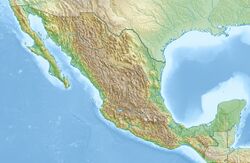Earth:Tlayúa Formation
From HandWiki
| Tlayúa Formation Stratigraphic range: Albian | |
|---|---|
| Type | Geological formation |
| Sub-units | Lower, Middle and Upper Members |
| Underlies | Unconformity with Eocene-Oligocene Pie de Vaca Formation |
| Overlies | Orizaba Formation |
| Thickness | Lower: 50 m Middle: 35 m Upper: 40 m |
| Lithology | |
| Primary | Limestone |
| Other | Mudstone |
| Location | |
| Coordinates | [ ⚑ ] : 19°06′N 98°12′W / 19.1°N 98.2°W |
| Paleocoordinates | [ ⚑ ] 17°06′N 61°36′W / 17.1°N 61.6°W |
| Region | Puebla |
| Country | |
| Type section | |
| Named for | Tlayúa Quarry |
The Tlayúa Formation is an Early Cretaceous (late Albian) geological formation near Tepexi de Rodríguez, Puebla.[1]
Paleobiota
The formation contains a diverse array of vertebrate and invertebrate fossils. About 70% of the macrofossils are osteichthyan fish.[2] Other vertebrates include chelonians, pterosaurs, lepidosaurs, and crocodiles.[3] Cyanobacteria, foraminifera, algae, gymnosperms, sponges, cnidarians, annelids, gastropods, ammonites, bivalves, arachnids, insects, isopods, anomurans, brachyurans, crinoids, echinoids, holothuroids, stelleroids, and ophiuroids, have also been recovered from the Tlayúa Formation.[3][4][5]
Lepidosaurs
| Genus | Species | Abundance | Notes |
|---|---|---|---|
| Huehuecuetzpalli | H. mixtecus | A primitive lizard | |
| Pamizinsaurus | P. tlayuaensis | An osteoderm-covered sphenodontian | |
| Ankylosphenodon[6] | A. pachyostosus | An aquatic sphenodontian | |
| Tepexisaurus[7] | T. tepexii | A basal scincomorph |
Other vertebrates
Mainly after González-Rodríguez (2016)[8]
- Araripichthys webri
- Armigatus carrenoae
- Armigatus felixi
- Axelrodichthys cf. araripensis
- Cipactlichthys scutatus
- Epaelops martinezi
- Macrosemiocotzus americanus
- Michin csernai
- Notagogus novomundi
- Nusaviichthys nerivelai
- Pachyamia mexicana
- Paraclupea seilacheri
- Quetzalichthys perrilliatae
- Ranulfoichthys dorsonudum
- Teoichthys brevipina
- Teoichthys kallistos
- Tepexichthys aranguthyrom
- Tlalocbatos applegatei
- Tlayuamichin itztli
- Unamichthys espinosai
- Ellimmichthys sp.
- cf. Amblysemius
- cf. Bananogmius
- Belonostomus sp.
- cf. Brannerion
- Lepidotes sp.
- cf. Lycoptera
- cf. Megalops
- Neoproscinetes sp.
- Notelops sp.
- cf. Paraelops
- cf. Rhacolepis
- Vinctifer sp.
- cf. Yabrudichthys
- Gonorhynchiform indet.
- Testudines indet.
Arthropods
- Archaeoniscus aranguthyorum
- Atocatlis ranulfoi
- Ixtahua benjamini
- Protaegla miniscula
- Tepexicarcinus tlayuaensis
- Sphaeromatidae sp.
Echinoderms
- Ophiactis applegatei
- Paleopentacta alencasterae
- Parapsolus tlayuensis
- Asteropecten sp.
- Echinaster sp.
- Ophidiaster sp.
- Plutonaster sp.
- Tamaria sp.
Plants
References
- ↑ Applegate, S. (1988). "A new genus and species of a holostean belonging to the family Ophiopsidae, Teoichthys kallistos, from the Cretaceous, near Tepexi de Rodriguez, Puebla". Revista Mexicana de Ciencias Geológicas 7 (2): 200–205. http://www.biblioteca.org.ar/libros/91228.pdf.
- ↑ Vega, FJ, ed (2006). "Mesozoic Osteichthyans of Mexico". Studies on Mexican Paleontology, Topics on Geobiology 24.. Dordrecht, Netherlands: Springer Verlag. pp. 169–207. ISBN 1402039859. https://books.google.com/books?id=xOw5s1g873oC&pg=169.
- ↑ 3.0 3.1 "A review of the Lower Cretaceous (Tlayúa Formation: Albian) Crustacea from Tepexi de Rodríguez, Puebla, Central Mexico". Bulletin of the Mizunami Fossil Museum (32): 25–30. 2005. http://www.city.mizunami.gifu.jp/sightseeing/mizunami/cultural_property/institution/Bull32/Vegaetal1.pdf.
- ↑ Buitrón-Sánchez, Blanca Estela; Durán-Gónzalez, Alicia; Martín-Cao-Romero, Carolina; Solís-Marín, Francisco Alonso; Laguarda-Figueras, Alfredo. "Lower Cretaceous (Albian) Asteroidea (Echinodermata) from Tepexi de Rodriguez, Puebla, Mexico" (in en). Revista de Biología Tropical 63 (2): 7–15. https://www.redalyc.org/journal/449/44943929002/html/.
- ↑ Solé, Jesús; Pi-Puig, Teresa; Bermúdez-Chávez, Cynthia; Garduño-Martínez, Diana; Alvarado-Ortega, Jesús (2022-12-05). "Mineralogy, geochemistry, and K-Ar dating of feldspars and clays from an exceptional Cretaceous fossil locality (Tlayúa, Puebla, Mexico): Insights into the depositional and diagenetic ages and processes". Chemical Geology 612: 121134. doi:10.1016/j.chemgeo.2022.121134. ISSN 0009-2541. https://www.sciencedirect.com/science/article/pii/S0009254122004284.
- ↑ Reynoso, V. H. (2000). "An Unusual Aquatic Sphenodontian (Reptilia: Diapsida) from the Tlayua Formation (Albian), Central Mexico". Journal of Paleontology 74 (1): 133–148. doi:10.1017/S0022336000031310.
- ↑ Vega, Francisco J.; Nyborg, Torrey G. (2006). "Research on Fossil Amphibians and Reptiles". in Landman, Neil H.. Studies on Mexican Paleontology. 24. Douglas S. Jones. Dordrecht, Netherlands: Springer. p. 214. ISBN 1-4020-3882-8. https://books.google.com/books?id=CXTGliRPN04C. Retrieved 31 May 2011.
- ↑ Rodríguez, Katia González; Fielitz, Christopher. CRETACEOUS OSTEICHTHYAN FISH ASSEMBLAGES FROM MEXICO. https://www.academia.edu/26614900/CRETACEOUS_OSTEICHTHYAN_FISH_ASSEMBLAGES_FROM_MEXICO.
Further reading
- L. Martin-Medrano and P. Garcia-Barrera. 2006. Fossil Ophiuroids of Mexico. In F. J. Vega, T. G. Nybor, M. D. C. Perrillat, M. Montellano-Ballesteros, S. R. S. Cevallos-Ferriz, S. A. Quiroz-Barroso (eds.), Topics in Geobiology 24:115-131
 |


